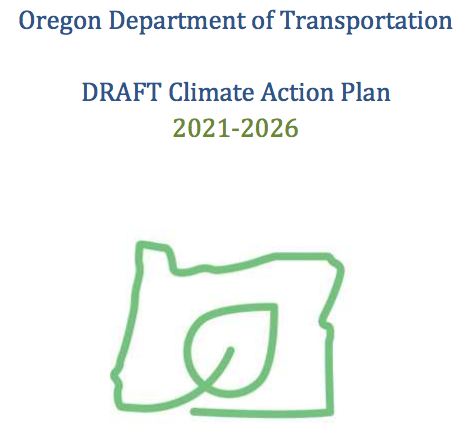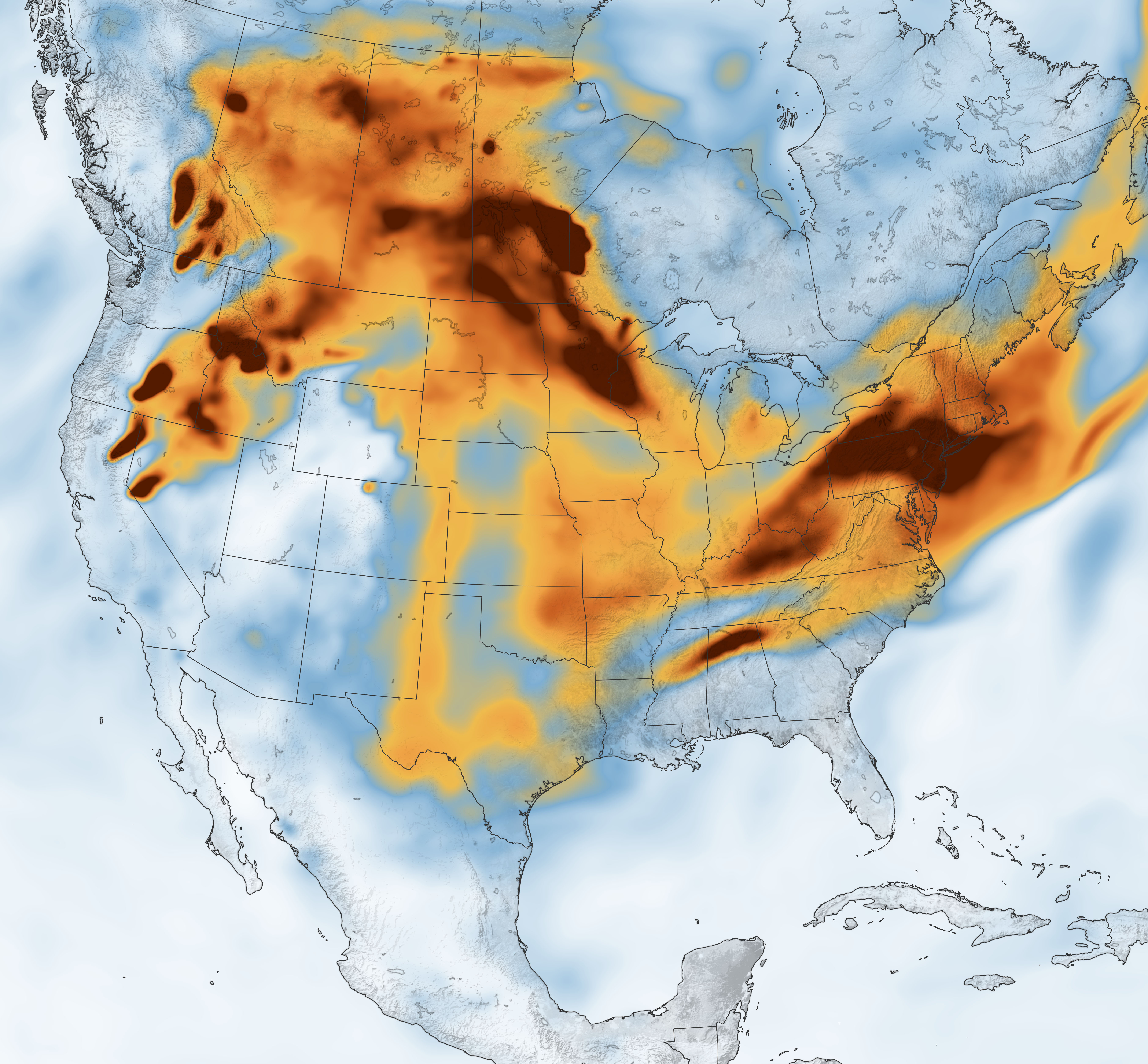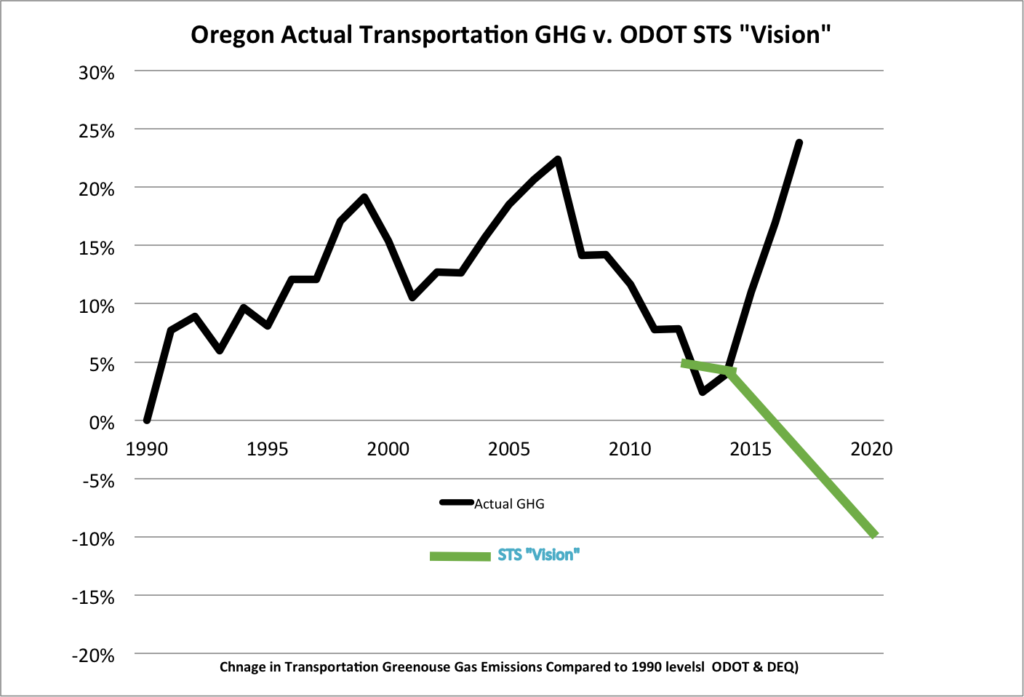The Oregon Department of Transportation is in complete denial about climate change
Oregon DOT has drafted a so-called “Climate Action Plan” that is merely perfunctory and performative busywork.
The devastation of climate change is now blindingly manifest. Last month, temperatures in Oregon’s capital Salem, hit 117 degrees. The state is locked in drought, and already facing more wildfires, on top of last year’s devastating fire season. Cities across the nation are swathed in the smoke from Western wildfires—largest among them Oregon’s Bootleg fire—and are daily witnessing orange-tinged sunsets.
Earth Observatory, July 2021.
All this is plainly due to climate change, and in Oregon, transportation is the leading source of greenhouse gases.
If there were every a time to change direction on climate, this would be it. But plainly, the Oregon Department of Transportation is locked on cruise control, moving ahead with plans inspired by the dreams of the 1950s rather than the increasingly grim reality of the the 2050s.
ODOT’s climate denialism
While the Oregon Department of Transportation mouths the words of climate awareness, the substance of its plans make it clear that it is engaged in cynical climate denialism. Its State Transportation Strategy (STS)—which claims to address state greenhouse gas reduction goals, never acknowledges that Oregon is failing to reduce greenhouse gases as mandated by law because of increased driving.
In Oregon, transportation, and specifically driving, is the largest single source of greenhouse gas emissions, contributing 40 percent of statewide greenhouse gases. And while we’ve made some progress cleaning electricity generation and reducing industrial emissions, transportation greenhouse gases are increasing, up 1,000 pounds per person annually in the Portland metropolitan area over just the last five years
To date, Oregon’s and ODOT’s plans to reduce transportation greenhouse gases have amounted to less than nothing. According to DEQ statistics, driving related greenhouse gases are were 25 percent above 1990 levels in 2018. Given the state’s objective of reducing greenhouse gas emissions 10 percent below 1990 levels by 2020 (and 80 percent below 1990 levels by 2050), we’re headed in exactly the wrong direction.
In the face of this epic failure to make progress, and in the wake of the most extreme weather ever recorded, ODOT is proposing to actually make the problem worse by spending billions widened Portland area freeways, and going deeply into debt to do so, as we discussed earlier.
As the Oregon Environmental Council and 20 other local environmental organizations wrote to the Oregon Transportation Commission:
Transportation-related emissions make up nearly 40% of Oregon’s total greenhouse gas emissions and continue to steadily increase. The investments that ODOT has made to address climate, while valuable, are profoundly insufficient given the scale and urgency with which we must reduce emissions to avert the worst of the grim and chaotic future we are already experiencing.
ODOT’s “climate action plan”: Cynical, meaningless and wrong
In theory, the Oregon Department of Transportation is going to combat climate change through is a five-year climate action plan, which is supposed to represent the agency’s response to a call from Governor Brown to take climate more seriously. It’s a sketchy and vague grab-bag of piecemeal and largely performative actions, packaged along with some deceptive claims about transportation’s contribution to climate change. And its policies make it clear that the agency is principally concerned with continuing to build more roads, and get ever larger budgets.
A fig leaf for business as usual
Appropriately, the plan’s signature graphic element is a single leaf—a fig-leaf as it were— superimposed over an outline of the map of Oregon. Never has an info-graphic been more appropriate: this document is fig-leaf covering what would be, upon any closer inspection, an obscene document.
 ODOT’s climate plan has no measurable goals and no accountability
ODOT’s climate plan has no measurable goals and no accountability
ODOT is a staffed by engineers, so you might think they’d have some actual quantitative measures of the problem they face, and the impact of the steps they’re proposing. his a remarkable plan which contains no statement of the problem in terms of quantities of greenhouse gases emitted, no goal for their reduction (to 25 percent of 1990 levels by 2050, as mandated by law), and no evidence that individually or collectively the measures described in the plan will have any quantitative effect on greenhouse gas emissions whatsoever. It’s merely a perfunctory checklist of actions, which once taken, will absolve ODOT of any further responsibility to worry about climate issues. There’s simply no accountability for any reduction in greenhouse gases.
The lack of accountability is apparent in the framing of the document; there’s no acknowledgement that transportation greenhouse gas emissions have gotten worse since the development of ODOT’s first climate fig-leaf, it’s “Sustainable Transportation Strategy” eight years ago.
Reducing GHG’s isn’t a priority: Getting more money for ODOT is
Climate may be in the title, but the substance of the plan is really about ODOT’s 1950s era highway-building values. It’s clear from the get-go that this strategy actually isn’t interested in reducing greenhouse gases. The document states clearly it has three main priorities (pages 7-8): promoting equity, building the transportation system, and assuring ODOT has enough money. Reducing greenhouse gases didn’t even make the list.
It’s worth noting that with equity, as with climate, there are no measurable objectives. It’s just lip service from an agency that has repeatedly pushed city destroying highways through minority neighborhoods, and which plans to atone for this damage by making the highways even wider.
Pricing is a source of revenue, not a means to manage demand or reduce climate pollution
Potentially, pricing could have a major impact on greenhouse gas emissions. Fuel consumption and greenhouse gas emissions actually did decrease through 2014 when gas prices were high. But ODOT has no plans to using pricing to achieve climate objectives. The plan mentions pricing, but only to pay for more roads; there’s no commitment to use pricing to reduce greenhouse gases, vehicle miles of travel or traffic congestion. The only stated policy concern is generating enough revenue to fund ODOT construction projects,
“Pricing: Price the transportation system appropriately to recover the full costs to maintain and operate the system.”
The plan contains no provisions to reflect price of environmental damage back to system users—ODOT wants to get paid to build more roads, but resists having it or highway users pay for the damage their emissions cause. As we’ve noted, ODOT backed off from pricing based in part on its consultations with avowed climate change deniers it appointed to its “stakeholder” group.
Falsely claims making traffic move faster will reduce emissions
The strategy repeats a false claim that Oregon DOT can reduce emissions by making traffic move faster. One of the plan’s action items is “System efficiency” which it defines as
“. . . improve the efficiency of the existing system to reduce congestion and vehicle emissions.”
What this really means, in practice, is that ODOT spends more money on elaborate computers, variable advisory speed signs and signboards that show estimated travel times on some highways. None of these so called “intelligent transportation systems” have been demonstrated to measurably reduce either congestion or greenhouse gases. Moreover, to the extent they do lower congestion, they induce additional travel demand, and the scientific literature has shown that increased travel more than wipes out any emission reductions from improved traffic flow. This is precisely the false set of claims that ODOT conceded it made to the Legislature in 2015 when it lied about estimates of emission reductions from these “system efficiency projects.”
It’s “climate lens” is really an eye-patch, turning a blind eye to induced demand
The climate plan says a “climate lens” will be applied to the State Transportation Improvement Program (TIP) projects, but is silent on the application of any such standard to megaprojects like the I-5 Rose Quarter project, the revived Columbia River Crossing or any of the billions in other proposed Portland area freeway widening projects. The induced demand calculator developed by the University of California Davis from the best available science shows these kinds of freeway widening projects will produce hundreds of thousands of tons of additional greenhouse gas emissions.
The so-called “climate lens” is simply a glib PR talking point that has no impact or meaning. If you were at all serious about climate, a real climate test would have the agency put on hold all additions to state highway capacity.
The climate plan reiterates a discredited claim that greenhouse gases can be reduced by widening roads and making traffic move faster, something that’s been shown scientifically to induce more driving and pollution.
Technocratic climate denialism
Future generations, enduring the brunt of increasingly intolerable summers and extreme weather, seeing Oregon’s forests and natural beauty decimated by climate change will look back to the decisions ODOT is making now and ask how it could simply ignore this problem, ignore the demonstrated science about its causes, and then commit literally billions of dollars to make it worse, dollars that future generations will be forced to repay.
This may seem like a simple, routine technical matter. It’s not. Its an irrevocable commitment to burn our state, to cower in ignorance in the face of an existential challenge, and an effort to cling to an outdated ideology that created this problem.


